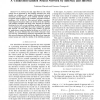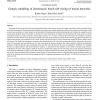954 search results - page 21 / 191 » Principles and Models for Organizing the IT Function |
CIBCB
2005
IEEE
14 years 1 months ago
2005
IEEE
- Establishing structure-function relationships on the proteomic scale is a unique challenge faced by bioinformatics and molecular biosciences. Large protein families represent nat...
PROCEDIA
2010
13 years 2 months ago
2010
This work presents an approach to the obstacle avoidance problem, applicable in the frame of driver assistance. A decision, expressed as a proposed acceleration vector for the veh...
IJCNN
2008
IEEE
14 years 2 months ago
2008
IEEE
— It is well known that edge filters in the visual system can be generated by the InfoMax principle. But, such models are nonlinear and employ fully-connected network structures...
NN
2000
Springer
13 years 7 months ago
2000
Springer
The proper functioning of the nervous system depends critically on the intricate network of synaptic connections that are generated during the system development. During the netwo...
FSS
2002
13 years 7 months ago
2002
Fuzzy clustering algorithms have been widely studied and applied in a variety of areas. They become the major techniques7 in cluster analysis. In this paper, we focus on objective...


